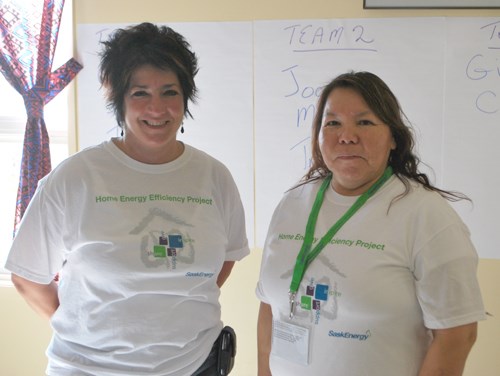While energy process are still low relative to the costs seen through 2007 and into mid-2008, a cold winter is still an expensive experience for people in older, less energy efficient households.
As well as cost, the comfort issues involved with drafty homes can drive people to distraction, and in light of the growing trend of energy conservancy, spurred in part by the global warming issue, making older residences more efficient has become and increasingly attractive option.
To support this move towards greater energy efficiency, SaskEnergy, in conjunction with SIAST (Saskatchewan Institute for Applied Sciences and Technology) and the Salvation Army, have set up the Home Energy Efficiency Project.
Originally designed to assist low-income home-owners and renters, the program in recent years has expanded considerably, and now includes projects aimed at assisting residents in First Nations communities with decreasing their home energy use.
White Bear First Nations was one of the most recent recipients of this program as SaskEnergy arrived at White Bear Post-Secondary Education Centre on Tuesday, Oct. 4, to help upgrade the 100 homes.
"We've joined up with White Bear First Nations, as well as the other sponsoring agencies, to assist in home3 upgrades for 100 residences on White Bear First Nations," aid SaskEnergy community coordinator Shannon Doka. "Today, we will be working with community volunteers, as well as volunteers from SaskEnergy, to install several energy saving items in the houses that will be chosen for upgrades."
The efficiency upgrade packages are valued at around $200 a pieces, and include many energy saving items.
Included in the package are compact florescent light bulbs to replace older incandescent ones, weather stripping for doors, insulation inserts for power outlets, new filters for furnaces, shrinkable plastic window membranes, low-flow shower heads and programmable digital thermostats.
"The teams will move out to residences that were selected through the White Bear Housing Authority throughout the day, installing the energy saving items," Doka said. "The only items our volunteer teams won't be installing are the thermostats and the weather stripping."
"We will be having a professional electrician attending the homes selected to install the thermostats," said White Bear Housing Authority representative and project volunteer Corrine Shepherd. "The weather stripping will also be installed by the authority."
"The selection process for the houses was done by the age of the home," Shepherd said. "The older houses were chosen first, and so on up the line."
"We will definitely be able to use all 100 upgrade packages."
As for the project itself, Shepherd was enthusiastic about the impact it would have on the community.
"I think the whole thing is great," Shepherd said. "It helps our people with energy conservation, and it educates people about [how] to help out with the environment."
More than 15 community volunteers, split into five teams, joined in with the SaskEnergy volunteers in getting the homes ready for winter."
"We were designated five houses this morning. I think we'll do another five this afternoon," said team member Lee Anne Littlechief. "It's been great getting these houses winterized, and it is really a great learning experience as to what we can do ourselves to improve how efficient our homes are."
In addition to the energy efficiency kits, SaskEnergy also supplied environmentally friendly cleaning product kits, containing earth- and energy-friendly items like cold-water Tide.
"This project is about more than just helping families become more energy efficient and lower their utility bills," said SaskEnergy manager of Aboriginal relations Gillis Lavalley. "The training provided today will help to create a long-term sustainability."
"The project will serve as an example for other community-based programs," Lavalley said, "which in turn will lead to improved self-sufficiency in Aboriginal communities across the province."
At lunch, SaskEnergy provided a community barbeque, open to all comers. Serving out hot dogs and hamburgers, the community-orientated focus of the program was illustrated.
"People who want to install the items themselves have been coming by throughout the day to pick up the packages," Doka said. "We really want this to be a community involved effort."




